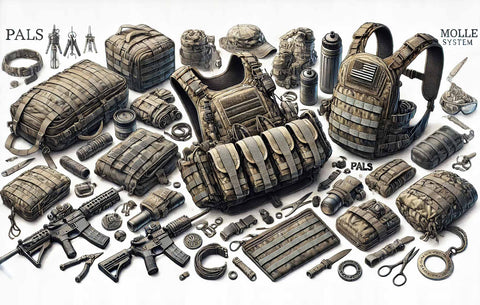The Modular Lightweight Load-carrying Equipment (MOLLE) system has revolutionized the way military personnel and outdoor enthusiasts carry and manage their gear. This innovative system provides unmatched flexibility and durability, making it a staple in various demanding fields. This article explores the workings, benefits, and various applications of the MOLLE system, from military deployments to outdoor adventures.
Origins and Evolution of MOLLE
The MOLLE system, an acronym for Modular Lightweight Load-carrying Equipment, originated in the late 1990s. Designed primarily for the American military, it saw extensive adoption starting in 2001, coinciding with military operations in Afghanistan and Iraq. Over the years, MOLLE has evolved beyond military use, with adaptations for civilian applications in fields like construction, park management, and more.
How the MOLLE System Works
At its core, MOLLE uses a series of nylon webbings, known as the Pouch Attachment Ladder System (PALS), to allow for the secure attachment of various components. This system enables users to attach additional equipment and pouches securely, ensuring that gear is tightly fastened and does not rattle during movement.
Customization and Flexibility
One of the system's main advantages is its high degree of customization. Users can configure their gear setups according to their specific needs, whether for a military operation or a weekend hiking trip. The system's versatility extends to various gear types, including tactical plate carriers, backpacks, and other load-bearing equipment.
For those looking to combine their MOLLE system with a high-quality tactical vest, our article on Choosing the Right Tactical Vest: A Comprehensive Guide for Enhanced Performance and Protection offers valuable insights into selecting a vest that complements the MOLLE system for optimal performance and protection.
Benefits of the MOLLE System
Enhanced Gear Distribution
The MOLLE system excels in evenly distributing the weight of the carried gear across the user’s body. This distribution helps maintain mobility and reduces fatigue, which is crucial during extended periods of wear. The compatibility with various modular components further enhances its effectiveness, allowing for tailored gear setups that meet the unique demands of different activities and professions.
From Military to Civilian Use
Initially designed for military use, the MOLLE system has found a broad audience among civilians. Its robust and flexible nature makes it ideal for activities like camping, mountain climbing, and even more casual pursuits like photography or bird watching, where easy access to equipment is essential.
MOLLE Attachments and Accessories
The development of the MOLLE system has led to the creation of a wide array of accessories, each designed to enhance the system’s functionality. These include:
- General-purpose pouches: Ideal for carrying a variety of tools and supplies.
- Specialized pouches: Designed for specific items like medical kits or hydration bladders.
- HEXGRID system by 5.11: A new innovation that allows for angular attachment, increasing the versatility of gear setup.
MOLLE vs. PALS: Understanding the Difference
While MOLLE and PALS are often used interchangeably, it’s important to note the distinction. MOLLE refers to the overall system, including the webbing and the attached gear. In contrast, PALS specifically denotes the webbing grid that facilitates the attachment of various components.
Conclusion
The MOLLE system represents a significant advancement in tactical and outdoor gear design. Its ability to adapt to various environments and requirements makes it an invaluable tool for anyone needing reliable, customizable gear management. Whether for professional military use or personal outdoor activities, MOLLE offers an efficient solution for carrying essential equipment securely and comfortably.
Further Reading
For those interested in exploring more about tactical gear and the MOLLE system, resources like ShieldConcept.com offer extensive insights and product reviews, helping both newcomers and seasoned professionals find the equipment that best suits their needs.
FAQs on the MOLLE System: Everything You Need to Know
What is MOLLE?
MOLLE stands for Modular Lightweight Load-carrying Equipment. It's a load-bearing system designed to enhance the modularity and customization of tactical gear for military and civilian uses.
How does the MOLLE system work?
The MOLLE system uses a series of webbed nylon strips, known as the Pouch Attachment Ladder System (PALS), to securely attach various components and accessories to gear like backpacks, vests, and belts.
What can be attached to a MOLLE system?
Almost any gear that can benefit from secure, modular attachment can be integrated with a MOLLE system, including pouches, holsters, first aid kits, hydration bladders, and even specialized tools like binoculars or cameras.
Is MOLLE used only by the military?
Initially designed for military use, MOLLE has gained widespread adoption among civilians, especially those involved in activities like camping, hiking, hunting, and even professional fields requiring robust gear management solutions like construction and law enforcement.
What are the benefits of using a MOLLE system?
The primary benefits include enhanced customization, improved load distribution, increased gear accessibility, and superior durability. These features make MOLLE ideal for anyone who needs to carry multiple pieces of equipment comfortably and securely.
How do I attach items to a MOLLE system?
Items are attached through a weaving process where the straps from the attachment are interlaced with the PALS on the gear, securing them with snaps or buttons at the end to prevent shifting or loss.
Can MOLLE systems be adjusted for different sizes?
Yes, one of the advantages of MOLLE systems is their adjustability. The webbing can accommodate various sizes and shapes of attachments, allowing users to customize the fit and configuration of their gear.
Are there different types of MOLLE systems?
Yes, there are several variations, including MOLLE II, which is specifically designed for Army Combat Uniforms. Innovations like the HEXGRID system by 5.11 Tactical also offer even more flexibility by allowing attachments at various angles.
Where can I buy MOLLE-compatible gear?
MOLLE-compatible gear is available at most tactical gear suppliers, outdoor retailers, and many online stores. Ensure that you purchase from reputable vendors to guarantee quality and compatibility.




